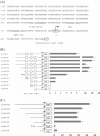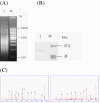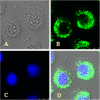Sf-PHB2, a new transcription factor, drives WSSV Ie1 gene expression via a 12-bp DNA element
- PMID: 22985503
- PMCID: PMC3511282
- DOI: 10.1186/1743-422X-9-206
Sf-PHB2, a new transcription factor, drives WSSV Ie1 gene expression via a 12-bp DNA element
Abstract
Background: The WSSV immediate early gene ie1 is highly expressed throughout viral infection cycle and may play a central role in initiating viral replication during infection.
Results: Here, a detailed characterization of the ie1 promoter was performed using deletion and mutation analyses to elucidate the role of the individual promoter motifs. Three results were obtained: 1) the ie1 promoter is a classical eukaryotic promoter that contains the initiator element (Inr) and TATA box responsible for the basal promoter activity; 2) mutation or truncation of a predicted Sp1 site decreased the level of promoter activity by about 3-fold, indicating that the Sp1 site is an important cis-element of the promoter; and 3) truncation of a 12-bp sequence that resides at -78/-67 of the ie1 promoter decreased the level of promoter activity by about 14-fold, indicating that the 12-bp motif is a critical upstream element of the ie1 promoter for binding of a strong transcription factor to drive the ie1 gene expression in the cells. Further, the 12-bp DNA binding protein was purified from the nuclear proteins of Sf9 cells using DNA affinity chromatography, and was identified as a homologue of the prohibitin2 protein (named as Sf-PHB2) using mass spectrometry. Furthermore, the DNA binding activity of Sf-PHB2 was verified using a super shift analysis.
Conclusion: These results support that the Sf-PHB2 is a novel transcription factor that drives WSSV ie1 gene expression by binding to the 12-bp DNA element.
Figures






Similar articles
-
Role of Litopenaeus vannamei Yin Yang 1 in the Regulation of the White Spot Syndrome Virus Immediate Early Gene ie1.J Virol. 2017 Feb 28;91(6):e02314-16. doi: 10.1128/JVI.02314-16. Print 2017 Mar 15. J Virol. 2017. PMID: 28077637 Free PMC article.
-
Shrimp NF-κB binds to the immediate-early gene ie1 promoter of white spot syndrome virus and upregulates its activity.Virology. 2010 Oct 25;406(2):176-80. doi: 10.1016/j.virol.2010.06.046. Epub 2010 Aug 3. Virology. 2010. PMID: 20684968
-
White spot syndrome virus annexes a shrimp STAT to enhance expression of the immediate-early gene ie1.J Virol. 2007 Feb;81(3):1461-71. doi: 10.1128/JVI.01880-06. Epub 2006 Nov 1. J Virol. 2007. PMID: 17079306 Free PMC article.
-
Penaeus monodon TATA box-binding protein interacts with the white spot syndrome virus transactivator IE1 and promotes its transcriptional activity.J Virol. 2011 Jul;85(13):6535-47. doi: 10.1128/JVI.02433-10. Epub 2011 Apr 20. J Virol. 2011. PMID: 21507980 Free PMC article.
-
A missing paradigm: deciphering endocrine innovations among diverging regulations of alleles, paralogous genes and orthologous genes.J Mol Endocrinol. 2025 Jan 11;74(2):e240092. doi: 10.1530/JME-24-0092. Print 2025 Feb 1. J Mol Endocrinol. 2025. PMID: 39670893 Review.
Cited by
-
Molecular Mechanisms of White Spot Syndrome Virus Infection and Perspectives on Treatments.Viruses. 2016 Jan 18;8(1):23. doi: 10.3390/v8010023. Viruses. 2016. PMID: 26797629 Free PMC article. Review.
-
Prohibitins: A Key Link between Mitochondria and Nervous System Diseases.Oxid Med Cell Longev. 2022 Jul 8;2022:7494863. doi: 10.1155/2022/7494863. eCollection 2022. Oxid Med Cell Longev. 2022. PMID: 35847581 Free PMC article. Review.
-
Association study of sepiapterin reductase gene promoter polymorphisms with schizophrenia in a Han Chinese population.Neuropsychiatr Dis Treat. 2015 Oct 28;11:2793-9. doi: 10.2147/NDT.S92986. eCollection 2015. Neuropsychiatr Dis Treat. 2015. PMID: 26604763 Free PMC article.
-
LvYY1 Activates WSSV ie1 Promoter for Enhanced Vaccine Production and Efficacy.Vaccines (Basel). 2020 Sep 8;8(3):510. doi: 10.3390/vaccines8030510. Vaccines (Basel). 2020. PMID: 32911686 Free PMC article.
References
-
- Chou HY, Huang CY, Wang CH, Chiang HC, Lo CF. Pathogenicity of a baculovirus infection causing white spot syndrome in cultured penaeid shrimp in Taiwan. Dis Aquat Org. 1995;23:165–173.
Publication types
MeSH terms
Substances
LinkOut - more resources
Full Text Sources

